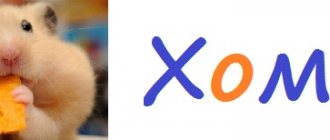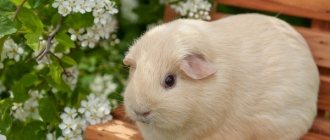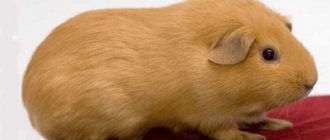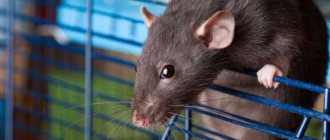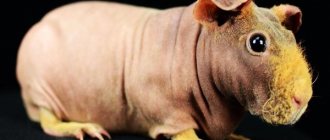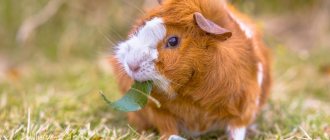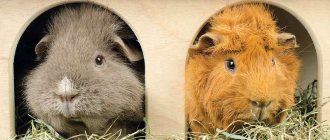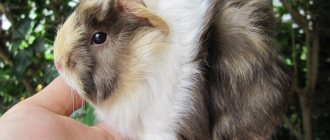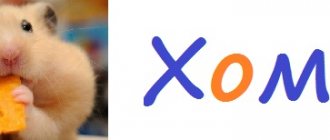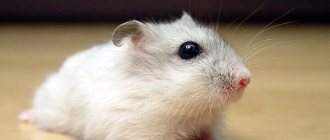- home
- Guinea pig
- Guinea pig breeds
02/18/2019 Among the variety of guinea pig breeds, the giant Kui guinea pig stands out. In size it is comparable to a small rabbit or puppy. Many countries breed them for agricultural purposes to use the meat for food. However, in European countries they are kept at home as pets. Unfortunately, not everyone knows about the existence of this breed.
Origin
The largest guinea pig in the world comes from South America. In Peru, Bolivia, Ecuador, and Colombia it lives in the wild. Favorite habitats are rocky and mountainous areas, where the animal can find a lot of vegetation, as it is a herbivore.
They live in flocks of about 9–10 individuals. This makes it easier to survive and protect offspring from attacks by predators. The pack has a leader - the largest male.
Outside its homeland, the kui guinea pig gained fame in the middle of the last century.
In Peru, in places where the breed is widely inhabited, its cultivation is promoted to solve the food problem. The second purpose is natural fertilizers, which are obtained from animal excrement.
Such “values” are not of interest to Kui breeders in other countries. They are trying to tame animals. So far there has been no particular success.
Anatomy, appearance
The huge Kui guinea pig differs in size: a massive skeleton, a wide skull. There are individuals who have extra toes on their paws. Although polydactylism is considered an anomaly, it does not affect the health of the cat. The weight of a rodent can reach 4 kg. Average weight 2 kg.
The hind legs are large, the body is stocky, the forehead is wide. The length of the body of the kui is about 40 cm.
These pigs are classified as smooth-haired breeds. The color can be different: one-color, two or three colors.
Several varieties of kui have been developed. In European countries, the Creole breed is preferred for home keeping in apartments. These pigs have an elongated body and muzzle. They don't gain much weight. The Peruvian Longhair breed is bred as a decorative species. Very beautiful merino. Their fur is curled, like that of sheep.
Choosing a cage: is it suitable?
Experts advise building an enclosure as an alternative to a cage. The height of the cage or enclosure should correspond to the height of the animal, so as not to make it difficult for it to stand up to its full height. It is undesirable to install an additional house inside the cage; the animal is prone to solitude, and with a house it is more difficult to tame the rodent.
It is recommended to have a maximum of two same-sex individuals in an apartment. Reproduction is allowed only in an aviary.
The home of a hamster or guinea pig should be located away from radiators, heaters and drafts. Constant exposure to direct sunlight is also undesirable. The best temperature for a comfortable stay is 16-20 C; a climate that is too hot or cold can have a detrimental effect on the health of the animal. If you decide to get an enclosure, you need to take care of heating your pet in the winter.
Complex nature
Kui owners, who have kept these animals since birth, resort to various tricks to tame the obstinate animal. This is very difficult, since an aggressive and naturally distrustful animal constantly shows its genetic tendencies, which are aimed at survival in this world.
You can’t be offended by animals, because in the wild, herbivorous animals with short legs always need to keep their eyes open. Once you scare a nervous kui at least once, your efforts to cultivate friendliness are dashed against a wall of mistrust. Even experienced guinea pig breeders cannot boast of being friends with kui.
There is another feature of the breed. If small relatives of a large pig need to be kept in pairs, then here the guinea pig is aggressive towards such a neighborhood.
Animals often start fights. Females are more conflicted than males.
Guinea pigs with long hair
Peruvian
Peruvians are the pioneers of these cute, long-haired animals. Selection for their breeding began already in the 1800s in Europe. The long, thin fur of pets falls on the sides and on the head. Therefore, if the pig is not a show pig, the “bangs” can be trimmed, otherwise they can be tied up or pinned. Breed standards require only a straight coat, without curls, and two rosettes - on the rump and head, near the nose. Their character is much calmer than that of other representatives; they can sit on their hands for a long time.
Sheltie and Coronet
Shelties can rightfully be considered the most pleasant to the touch. Compared to the Peruvian, the silky representatives do not have a parting on the back, the fur falls back. True shelties should not have any rosettes, and the covering on the head is much thicker, creating a kind of mane. Like many long-haired guinea pigs, they also have a calm temperament. But Coronets are rightfully the most active among the longhaired ones. They are distinguished by a single rosette on the head, the glossy long fur from which falls beautifully on the sides without covering the face. Pets that do not participate in exhibitions are usually cut into a bob so that the coat does not become dirty. It took much longer to produce modern Coronets than the breeds described above. To understand for yourself which guinea pig is the best of the breeds with such a hairstyle, you should pay attention to the character. The most peaceful and slow are Peruvians and Shelties, the most active and playful are Coronet. But the latter can also sometimes be in a phlegmatic mood.
On the left - Peruvian, in the middle - Sheltie, on the right - Coronet
Features of selection
Animals develop quickly. Sexual maturity occurs at 3–4 months.
To catch a favorable “moment” for breeding, breeders select the youngest females before they get fat. Once the animals gain excess weight, they are not suitable for procreation. It is extremely dangerous for overweight animals to carry babies.
To get healthy offspring, the pedigree of the animal is carefully studied. It is necessary to take into account the weight that your ancestors had. They try to find couples who are not prone to obesity.
Under no circumstances should large cuis be mixed with representatives of other breeds for procreation. Such “amateur activity” in selection will lead to congenital anomalies in the cubs. The animals will be very sick and most likely will not survive.
A newborn baby can weigh more than 0.1 kg. If a female is diagnosed with obesity, then she will not be able to cope with such a birth.
Rules of care and maintenance
The large guinea pig is not widely distributed due to its complex nature and short life expectancy. And finding a purebred animal is not so easy.
If you decide to have a kui as a pet, you need to take into account the peculiarities of keeping it in captivity and know how to feed it correctly.
The maintenance and care rules are as follows:
- Your pet needs to purchase a spacious cage, at least 1.5 square meters. m.
- An enclosure for walking is set up next to the cage, at least two meters in length.
- The bottom of the cage should be made of plastic and covered with sawdust with a layer of 10 cm.
- Once every 10–15 days, the animal should be bathed in a basin of warm water using zoo shampoos.
- Once every 5–6 months, the animal’s claws are trimmed with special tweezers.
- All bedding in the cage should be changed at least once every 3 days, and the places that the rodent has chosen for the toilet should be changed daily.
- Feeding should be moderate. The diet should consist of fresh hay, vegetables, herbs, and fruits.
It is necessary to provide the kui with fruit twigs and mineral stones for grinding down teeth.
You cannot feed your pig porridge, mixed feed and grain. This will be a disservice. She will quickly get fat and get sick.
Cui you, or the Three most striking national dishes of Peru
My blog statistics show that the greatest interest so far has been generated by publications about Peru, a country that my family and I discovered quite by accident this year and which we strongly recommend to everyone as a tourist destination.
I have already written a lot about various amazing places in Peru that not only amaze the imagination and leave the most vivid emotions, but can also change the view of the history of human development. However, when talking about the peculiarities of the country, one should never forget about the peculiarities of the national cuisine, because few things can characterize a country as well as its gastronomy. Just imagine - what goes better with German burghers than foamy beer and pork sausages with cabbage? For Russians - pancakes, dumplings and borscht? For Georgians - aromatic shish kebab, khinkali and kharcho? A country's main dishes reflect its national character and the various twists and turns of its historical path.
Today I want to talk about three, in my opinion, the most striking national dishes of Peru, through which, as if through a prism, new facets of this country are revealed.
I bet that one of them is familiar to you and you have tried it all, you associated the second with a completely different country, and about the third you didn’t even suspect that it existed.
No. 1. Corn (another name is maize)
Probably many of you, seeing corn as the first national dish, grinned. Everyone has tried it, so what’s wrong with it – corn and corn. Friends, but you have never tried corn like the one in Peru. This is something absolutely fantastic, delicious, from a completely different planet. Peruvian corn is as similar to ours as an adult seasoned wolf is to a mongrel living in a kennel.
If Nikita Sergeevich had gone not to the USA, but to Peru, then we would not have avoided sowing all the areas with corn, because it is absolutely impossible to forget it.
Imagine a small cob of corn, but with grains the size of a very large pea - or a hazelnut, and you will understand what kind of corn grows in Peru. Of course, first of all, it is also a feed crop for livestock, but the Peruvians themselves are very fond of it as a national delicacy. Fresh cobs are boiled in boiling water and served directly in a corn leaf (no cellophane). And - no salt! Instead of salt, Peruvians eat boiled corn with salty goat cheese. The grandmothers who sell corn (yes, grandmothers sell it there too) are equipped just like that - on one side there is a vat of corn, on the other there is a bag of goat cheese, a large slice of which they will generously cut off for you in addition to the cob.
Peruvian corn tastes much better than even Brazilian corn (which we tried on the beach), to say nothing of those unfortunate brothers of this plant growing in our latitudes. Juicy, milky, aromatic. In general, a feast of taste (“feast of the spirit”, hahaha, for those in the know).
Interesting facts about Peruvian corn:
- In addition to the familiar yellow corn, black corn is also common in Peru. It looks very unusual, I can’t say how it tastes because I haven’t tried it. Black corn is used to make one of the most popular national drinks of Peru - chicha morada, a non-fermented non-alcoholic drink that is great to quench your thirst on a hot day.
- In total, more than 50 varieties of corn are grown in Peru. However, in terms of corn production volumes, Peru ranks only 45th in the world, approximately 200 times inferior in volume to the leader of the list, the United States, and 7 times inferior to Russia.
- According to scientists, corn as a cultivated plant appeared on the territory of modern Mexico approximately 7-12 thousand years ago (this is evidenced by excavations at sites of ancient Indians). Interestingly, corn cobs in those days were about 10 times smaller than modern varieties, and did not exceed 3-4 cm in length. The current size of the cobs is the merit of the Indians who carried out the selection of this plant.
No. 2. Ceviche (raw fish)
(emphasis on the penultimate syllable, according to the rules of the Spanish language - on the letter “and”).
Ceviche in a restaurant in Lima
I am sure that most of our compatriots associate raw fish as a dish, first of all, with Japan. And how can one not associate it with Japan, when at every step in a more or less large city there are numerous sushi restaurants, bars and cafes.
So, Peru, with no less reason than Japan, can lay claim to the title of a country whose national cuisine includes raw fish. This dish is called ceviche (or sebiche - the Spanish language does not distinguish between the sounds “v” and “b”, so Vanya and Banya for them are one and the same, as in the famous Russian joke).
Ceviche is considered a real calling card of Peru. The basis of ceviche is fresh, finely chopped fish, after marinating for 15 minutes in citrus, lemon or lime juice. Chili peppers, rokoto or ahi (aji) and red onions are used as seasoning. With a side dish of sweet potatoes, corn kernels, avocado and lettuce, this ceviche recipe is recognized as the standard for preparing the national dish of Peruvian cuisine.
There are thousands of variations of ceviche, but this dish has one thing in common – the extraordinary freshness of the ingredients, thanks to which you can eat them without fear of getting poisoned.
Initially, ceviche was made with the juice of the local tumbo fruit, a bit like mini-bananas; after the Spanish colonization, oranges began to be used, and now they are prepared with lime juice, which in Peru is called lemon. Ceviche is the main subject of experimentation by local creative chefs and a favorite home-cooked food of Peruvians.
To be honest, I’m not a fan of raw fish and couldn’t bring myself to try it, but Lena happily ate a whole plate of ceviche at a local restaurant (to her credit, without flavoring this food with alcohol, which I certainly would have done).
Interesting facts about ceviche:
- Ceviche began to be prepared back in the Inca era - there is evidence of the Spanish conquistadors, whom the Indians treated with pieces of marinated fish in a slightly sour and spicy liquid.
- As a by-product of cooking ceviche, a sauce called “tiger milk” (leche de tigre) is formed. This is a milky sauce that is formed by the interaction of fish proteins and sour citrus juice. Some consider it an aphrodisiac, but regardless of this, “tiger milk” is one of the favorite sauces of Peruvian gourmets.
- Having started its popularity in Peru, ceviche is now widespread throughout Latin America (although, of course, it is primarily associated with Peru).
No. 3. Kui (fried or baked guinea pig)
If you want to impress a European, tell him that you ate guinea pig. At first they will look at you with surprise, then with some disgust, then they will start asking questions. It turns out that guinea pig is one of the most striking, iconic national dishes of Peru, completely unusual for you and me.
However, Peruvians treat pigs in much the same way as we treat rabbits. Pigs here are bred on special farms, which are widespread. This is what an ordinary farm looks like with an output of 150 kui per week:
Queen farm in Peru
Farmers sell kui at a price of $4-5 dollars per carcass. In the markets, it sells raw for $8 dollars, and cooked for $10-12. and more expensive.
The name “kuy” comes from the language of the Quechua Indians and translated means “guinea pig”. The name seems strange to the Russian ear, but it is just a sound imitation (remember what pigs do when they are looking for food - kui-kui-kui, and you will understand where the name came from). In Russian, of course, it sounds discordant, so when we bought Yura a small toy - a furry kuy - our guide Olga suggested calling this pig not kuy, but kuysito (a diminutive suffix in Spanish).
It’s hard to imagine, but there are still herds of wild cuis running around in the Peruvian mountains. They prefer areas near the banks of mountain rivers and are often found in abandoned ruins. Domestic cuys can be found in any Quechua Indian house, where the pigs move completely freely underfoot until it’s time for dinner :).
Cuy is the favorite food of many Peruvians, so much so that there are even special restaurants (cafes) specializing in it (like our kebab shops). This is also an excellent attraction for tourists - the dish is presented in all restaurants of national cuisine, and it is quite expensive (on average, one kui costs 1000-1200 rubles in a tourist restaurant, in establishments for locals it costs about half as much).
To prepare kui, it is first pulled onto a thick wooden skewer to give it hardness and elasticity, and then fried either on a regular grill or in a special oven.
In more expensive restaurants, kuya is prepared in such a way that its natural shape is not lost, so the oven is most often used. We ate kuya cooked in exactly this oven:
Kuya baking oven
If we ignore the form of the dish and move on to the content (i.e. taste), then I can say that kuy is like a rat. There is not enough meat, you need to literally gnaw it off the bones. I did not feel any foreign odors or tastes, i.e. in principle, everything is quite pleasant, but I cannot call it a super delicacy. Although our wonderful guide Nina (by the way, she’s Russian, she’s just lived in Peru for a long time) said that her family often goes to eat kuya in specialized restaurants and really loves this dish.
To conclude the post, here are some interesting facts about this unusual dish:
- Peru consumes about 22 million cuevas per year (that is, approximately 0.7 pieces for each of the 32 million Peruvians). Most likely, this figure does not take into account the cuys that are grown on peasant farms for their own consumption (since they do not appear in any statistics).
- The Incas had a saying: “If you grow a kuya, you eat well,” which reflected the importance of this animal for the meager diet of the mountain inhabitants.
- Peruvians believe that Jesus and the apostles at the Last Supper ate cuya, which, despite the lack of meat, is still considered a nutritious protein-containing dish and is associated by many Peruvians with some kind of holidays or celebrations. Below is the famous copy of Leonardo da Vinci's fresco (Last supper), creatively reinterpreted by the Peruvians.
“Last Supper” in Peruvian
You can notice that on the table in front of Christ and the apostles there is cuy on a platter, there are papayas among the fruits, and chicha is poured into the Inca goblets. Peruvians did not simply copy famous works, but added to them details that surrounded them in everyday life. Now this painting hangs in the main cathedral of the city of Cusco:
Main Cathedral in Cusco
Read my other publications about amazing Peru:
Cusco - the ancient capital of the Incas - a story about the central city of the Sacred Valley of the Incas, the ancient capital of this people. One of the most wonderful places in Peru.
The Sacred Valley of the Incas is a detailed story about all the amazing sights of the place in the valley of the Urubamba River, where the capital of the ancient Inca Empire was located.
How to get to Machu Picchu without going crazy - the name speaks for itself :). The publication details logistics to Machu Picchu as of May 2022.
Machu Picchu - truth and fiction about the legendary city of the Incas - a story about visiting the most famous landmark of Peru in May 2022, which is accompanied by interesting and little-known details from the history of Machu Picchu
The gods who created ancient civilizations - a detailed material about how the entire version of human history that we are told in schools has nothing to do with what actually happened. Amazing facts and evidence that I personally managed to see and touch.
Lima - a city of contrasts - a story about one day spent in the capital of Peru, Lima.
PS Subscribe to blog updates so as not to miss new posts:
Additional information about the breed
A large guinea pig is not intended to be kept as a pet. It is difficult to play and “communicate” with such an animal. Therefore, you should not buy it for a child.
A pig can show a wild temperament and bite a person. Therefore, there is no need to provoke such actions. If you decide to have such a pet. It must be handled with care and gentleness despite its large weight and dimensions. The animal is nervous and extremely sensitive to voice intonations. If he senses aggression or danger, he will immediately react by running away or trying to defend himself.
It is convenient to purchase a large pig if you can keep it in a yard with a large enclosure and a covered house in a cage.
